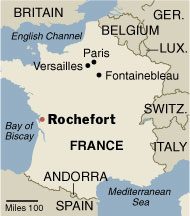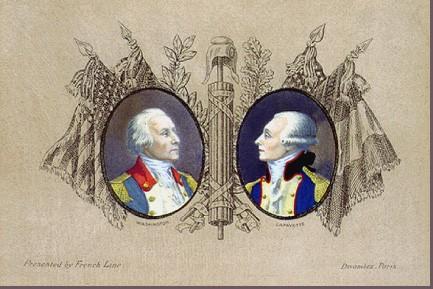Notre-Dame de Paris as seen from the South transept.
Viollet-le-Duc at the basis of the spire.
He saved the Cathedral in the 19th century.
The apse of the cathedral.

Notre-Dame de Paris, the West front.
Work was begun on the choir at Notre-Dame, as was customary, and finished after 20 years in 1180. Next came the nave. It had double side-aisles, with tribunes above, to compensate for the weight of the vaulting.
The leap into the Gothic did not occur in Paris without countless experiments and studies. The first crossed ribbed vaults appeared in Saint-Martin-des-Champs and Saint-Germain-l'Auxerrois, while the Gothic choir of the abbey of Saint-Denis was consecrated in 1163, the very year that Pope Alexander III laid the cornerstone of Notre-Dame. It was the abbot of Saint-Denis, Suger, who is credited with the invention of the Gothic Style, who turned the technical development into a thoroughly worked-out system of design.
The seventy-fourth successor of Saint-Denis was stung in action by the triumph of Abbot Suger; as the papal legate put it, Paris was "the furnace in which the intellectual bread of humanity was being baked". Maurice de Sully, son of a wood-gatherer on the banks of the Loire, had endowed Fleury-sur-Loire (Saint-Benoît) as one of the largest abbeys of the western world before he came to the Capetian capital. Here he studied at the school of Hugues de Saint-Victor, where he learned geometry and order. He was shortly to become a classic example of the 12th century prelate; preacher, bishop and builder and equally a counsellor with the ear of the king.
Work was begun on the choir at Notre-Dame, as was customary, and finished after 20 years in 1180. Next came the nave. It had double side-aisles, with tribunes above, to compensate for the weight of the vaulting. The flying-buttresses had not been developed yet, and were added later during the 13th century. By the time Maurice de Sully died in 1196, the nave was in use for services. The vault, at 35 metres above the ground, was eight to ten metres higher than any other of its time; it was one of the highest buildings in Christendom.
The façade was built under the episcopacy of Eudes de Sully, in the first half of the 13th century; it has a special beauty that stems from the harmony and power of its three, equally-balanced levels, doorways, gallery of kings and the great rose window, and twin towers. It was the wonder of its age, and one contemporary, disturbed at such audacity, exclaimed that it would be the most beautiful façade yet built "if ever it could be finished".
The house of God was also the house of the people. They came here to pray, naturally, but also ate, slept and conducted their business here. The narrow forecourt was full of traders' stalls; bakers selling bread; baskets full of haunches of lamb dripping blood; on the day before Lent, the City's largest pork fair was held here. Merchants even milled around inside the church, in the shadow of the pillars, selling candles or oriental jewels. On feast days, garlands of sweet-smelling flowers and herbs were strewn on the ground as the cathedral chapter made its solemn processions.
Read the whole article here:
http://france.knoji.com/notredame-de-paris-harmony-and-audacity/
La France fête, cette année, le 850ème Anniversaire de Notre-Dame de Paris. L'occasion ici de chanter cette magnifique cathédrale, chef d'oeuvre abouti du Gothique. Sauvée de la ruine par le génial Viollet-le-Duc, au XIXème siècle, la cathédrale ne cesse d'émerveiller et d'enchanter ses visiteurs.





Aucun commentaire:
Enregistrer un commentaire